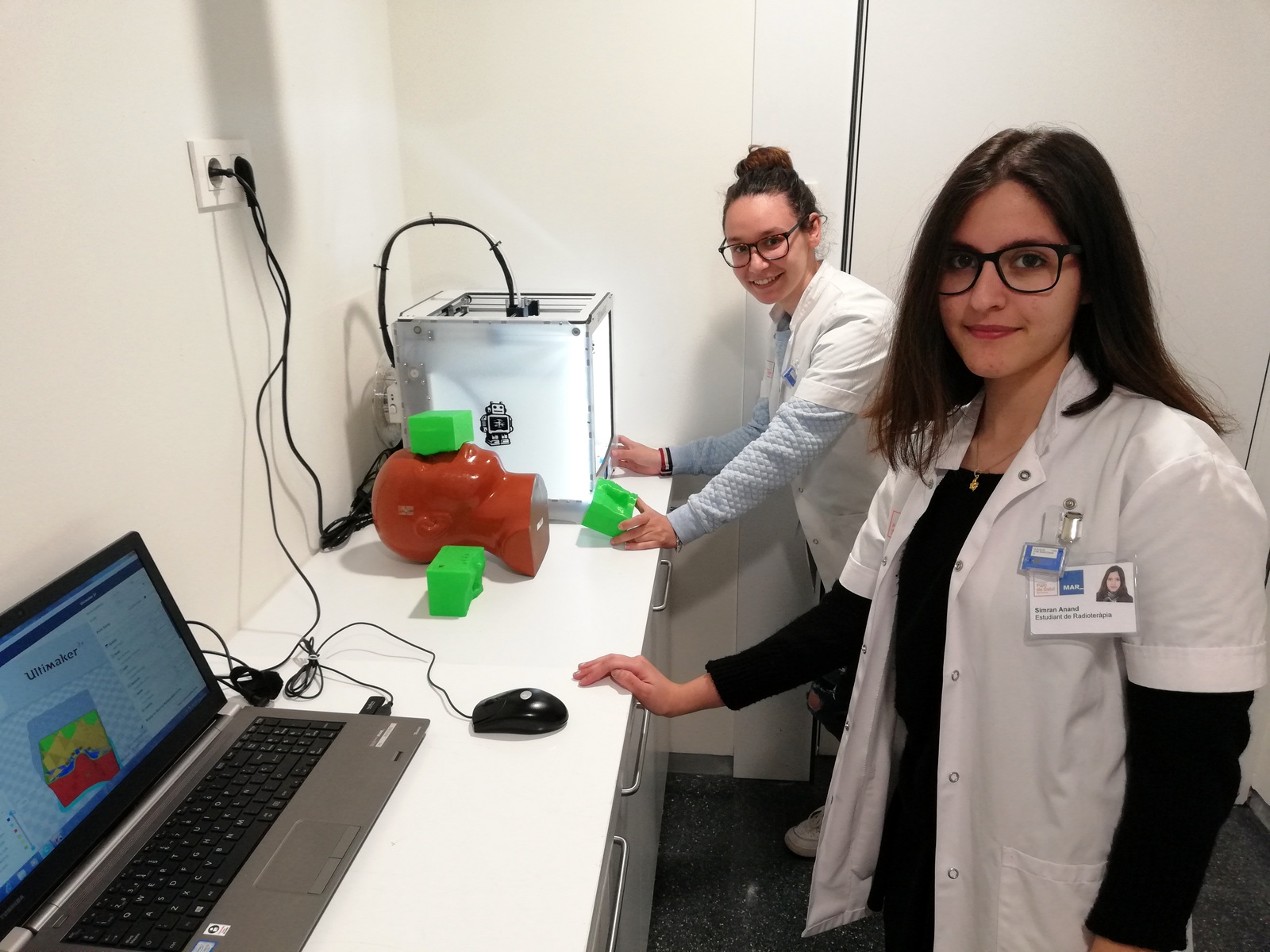Students of Biomedical Engineering are working at Mar Hospital on 3D printing and radiotherapy to treat skin cancer
Students of Biomedical Engineering are working at Mar Hospital on 3D printing and radiotherapy to treat skin cancer
Students of Biomedical Engineering are working at Mar Hospital on 3D printing and radiotherapy to treat skin cancer
Elena Monfort and Simran Anand, students of the third year, are doing their internships at the Radiation Oncology Service at the centre, a pioneer in Spain in successfully implementing this technique that brings benefits to the patient and reduces treatment side effects.
Mar Hospital is the first centre in Spain to use 3D printing to treat skin cancer with small tumours using high dose rate (HDR) plesiotherapy, a type of contact brachytherapy in which the source of radiation is located in or near the affected area. The team of the Radiation Oncology Service has worked for two years to validate the application of 3D printing in brachytherapy.
 This technique is better suited to the treatment and the dosage for each patient, it is more comfortable for the patient, saves hospital visits, and minimizes any discomfort caused by radiation on the skin. The addition of 3D printing has been possible thanks to the collaboration of the company BSDI-3DBOTICS, of the 3DLAB SL group, and of Elena Monfort and Simran Anand, internship students (January to July 2018) taking the bachelor’s degree in Biomedical Engineering at Pompeu Fabra University, who are being directed by Òscar Pera, technical manager of the project and physicist and physician at the service.
This technique is better suited to the treatment and the dosage for each patient, it is more comfortable for the patient, saves hospital visits, and minimizes any discomfort caused by radiation on the skin. The addition of 3D printing has been possible thanks to the collaboration of the company BSDI-3DBOTICS, of the 3DLAB SL group, and of Elena Monfort and Simran Anand, internship students (January to July 2018) taking the bachelor’s degree in Biomedical Engineering at Pompeu Fabra University, who are being directed by Òscar Pera, technical manager of the project and physicist and physician at the service.
The 3D printer allows automating and improving the quality of the process
The 3D printer allows automating and improving the quality of the manual moulds used for brachytherapy administration. The patient, having been assessed by the hospital’s Skin Cancer Functional Unit, undergoes a scan with computer tomography (CT) equipment, which provides an image on which a mould will be designed. To date, this process was done manually, on the patient, using thermoplastic material. Now, the professionals of the service have created their own computer program (Matlab) which interprets the CT and makes it easier to decide where to place the radioactive sources in order to irradiate the tumour. Once the design is ready it is sent for 3D printing. When printing is finished, the patient undergoes a second scan with the mould to confirm that it fits perfectly.
Specific tasks carried out by the students of the bachelor’s degree in Biomedical Engineering
Elena Monfort and Simran Anand explain that “with the help of professor Òscar Pera, we take care of creating the moulds for patients, as well as the optimization of the Matlab computer program code to streamline the logistics of treatment process”. “The idea of working in the hospital came up after some practical classes we did in the Pathophysiology course and since our training includes physical and medical issues, we thought it was a good choice to start working in the field of radiotherapy and 3D printing at Mar Hospital”, they add.
In order to perform this work, the training acquired on the bachelor’s degree in Biomedical Engineering, both in Matlab programming and 3D design (Freecad, Meshmixer), as well as in physiology, pathophysiology and radiological physics, mainly, has been essential. “Having this opportunity while we are studying has helped us to learn more and apply the knowledge that we are acquiring every day. Working and studying at the same time has forced us to learn how to organize both our work time and our personal time”, say the internship students.
Multidisciplinary studies with prospects for the future
With regard to two students’ future prospects, Elena says: “I chose Biomedical Engineering because it is multidisciplinary, between physics, mathematics and medicine. My prospects for the future are very much related to the internship I’m now doing at Mar Hospital, since I’d like to be able to include the figure of the biomedical engineer (which many people do not know about) in medical services, so as to improve some processes and provide new techniques to medicine”.
For Simran: “right from the outset I was interested in combining the biological and mathematical parts, and thinking that in the future I might help people motivated me to join this degree. In the future, once I graduate, I plan to do a master’s degree related to the subject and then try to get a job. Today I’m still not sure what job I would like to have since there are lots of things on the degree that interest me, so I’m open to any opportunity”.
